My first inkling that Phonsavan, Laos was not the sleepy little town it first appeared to be came when I walked past a row of rusty old bombs standing on the sidewalk outside Craters Restaurant. Curiosity and my growling stomach led me inside, where the owner was just putting on a documentary about the Laos Secret War, the U.S. bombing of Laos during the Vietnam War. For the next hour I sat, spellbound and horrified, as I watched the film unfold.
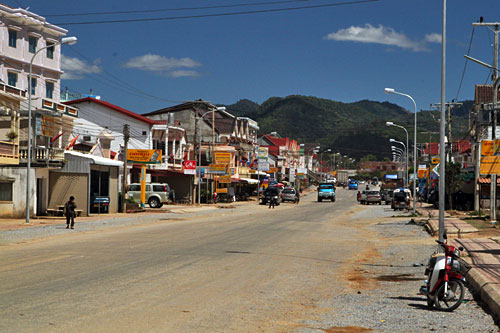
From 1964 to 1973, the U.S. flew 500,000 missions and dropped two million tons of bombs on Laos, two tons for every man woman and child in the country, making it the most heavily bombed country in history. Nearly a million of these were cluster bombs designed to break apart in mid-air, releasing more than 600 small round bomblets loaded with explosives and ball bearings. Upon impact, the ball bearings screamed through the air at 2,000 feet per second, tearing into the flesh of anyone within half a kilometer.
Since the bombings were a violation of the Geneva Accord, which prohibited military involvement in Laos and to which the U.S. had become a signator in 1962, the CIA conducted the criminal operations in utmost secrecy. Neither the American people nor Congress were told about the campaign, which began in earnest in 1968, following President Lyndon B. Johnson’s announcement that all air, naval, and artillery bombardment of Vietnam would cease. Missions were focused on two areas of Laos: in the north they were directed against the Pathet Lao communist insurgents who were fighting the Royal Lao Army, while bombings in the south targeted the Ho Chi Minh Trail in a futile attempt to cut off supplies being delivered to North Vietnam.

Unfortunately, enemy troops were the least affected; civilians in rural areas bore the brunt of the bombings. Unable to plant rice due to the daily bomb runs, they fled to area caves, where they lived in a near state of starvation for years. When the criminal action was finally exposed and military operations ceased, Laotians emerged from the caves, only to confront another kind of terror. Up to 30% of the bomblets, which Lao call “bombies,” had failed to explode upon impact, leaving a legacy of 10-30 million unexploded bombies scattered across the country.
The two most prevalent types of these devices are small enough to be held in the hand. The first, about the size of a tennis ball, attracts children who are often killed or maimed when they toss them around like toys. The second type, a bright yellow “Pineapple” bomb, is often mistaken for a similarly colored local fruit. Since the end of the war, this unexploded ordnance (UXO) has caused more than 200,000 casualties and uncountable injuries in the form of lost limbs and eyesight. Founded with the assistance of the United Nations, UXO Laos is the government organization charged with the responsibility for all UXO in the country. Although they destroy more than 100,000 pieces each year, at the current rate of removal it is estimated that it will be 100 years before Laos is free of UXO.
Though the loss of life and injuries are appalling, even more concerning is that UXO binds Laos in a perpetual state of poverty. Danger exists whenever there is a need to dig, thus development of infrastructure suffers. Roads, water and power lines, toilets, schools – none of these can be built until an area is first cleared of UXO. And though the country is blessed with an abundance of fertile soil, rural farmers are afraid to expand their fields for fear of being blown to bits. Trapped in abject poverty and facing starvation for a full half of each year, rural families are driven to collect UXO for its scrap metal value, despite the danger. Markets around town are full of eating utensils, kitchen pots, and hand-held farm implements that have been crafted from UXO casings. Disarmed bombs and missiles decorate the doorways and sidewalks all around Phonsavan. In addition to the half-dozen that stand sentinel in front of Craters Restaurant I saw several cut in half lengthwise and used for planters and a few even used in the foundations of houses. Larger bombs have been pounded into plows and used as fences, animal troughs and planters.
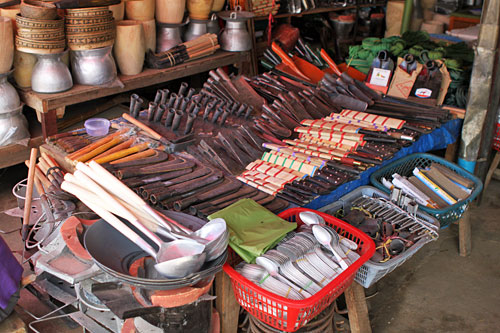
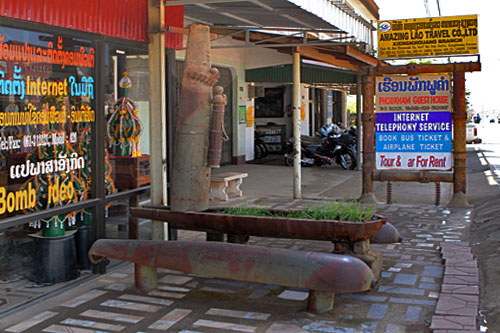
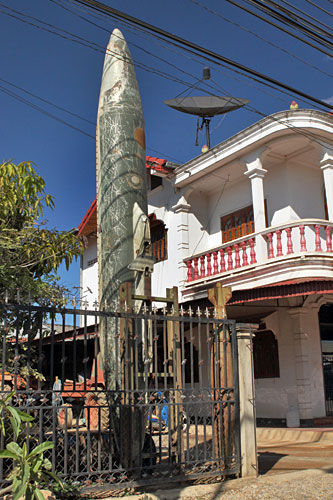
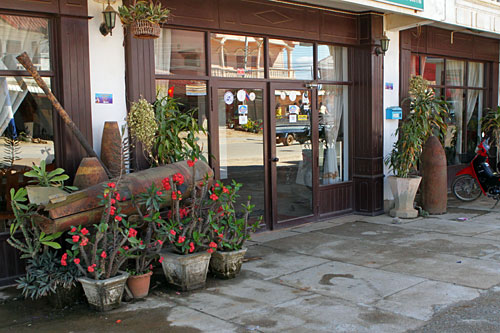
The day after visiting Site 1 at the Plain of Jars (which had thankfully been cleared of UXO) I stopped by the Xieng Khouang UXO Survivor Information Center on the main street of town, where I met Bounmy Vichack. Bounmy unearthed a bombie while digging a pond for the cultivation of fish on his family farm; when it detonated he lost his left arm and his face is pockmarked with scars from the shrapnel. “I worried about the future after the accident, about how I would support my family,” he explained. Today he works as a field assistant at the UXO Survivor Information Center, which facilitates the treatment and rehabilitation of victims and disseminates information about the dangers of UXO.
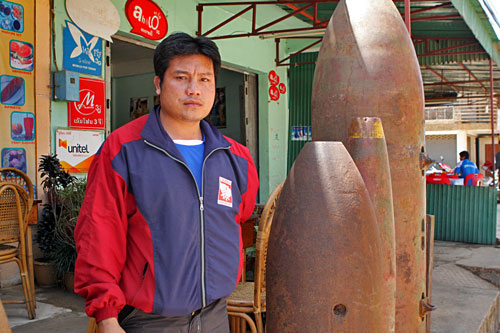
Through Bounmy I met Stephen Sonderman and Rachel Haig, who work with Spirit of Soccer (SOS), a non-profit organization that uses soccer to teach children about UXO and land mines. The couple left their stressful corporate jobs in Portland, Oregon, intending to backpack around Asia for four months, but ended up staying in Cambodia when she was offered a job in a Phnom Penh law firm. There she met the founder of SOS and began volunteering for the organization; a year later she quit her job at the law firm and went to work full time for SOS. Stephen was soon brought into the fold to work with the Ministries of Education in Iraq and Cambodia, countries also severely affected by UXO and land mines. In recent months the program, which is funded in large part by the U.S. State Department, has expanded into Laos.
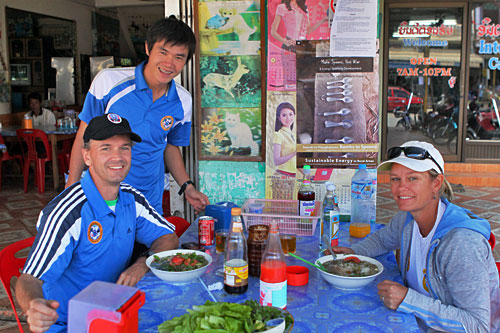
Children who have been raised in affected areas tend to ignore the dangers. “The kids see UXO all the time but don’t report it because they think it’s normal – that everyone has it.,” Rachael explained. Once they have gained the respect of the kids through soccer coaching, they incorporate education about UXO and land mines. “We kick a soccer ball hard and tell the kids to outrun it. Then we explain that the distance they just ran is the blast radius for UXO,” Stephen said. During breaks in play, they hold up photos of bombies and ask where the kids have seen such devices; their comments are turned into hand drawn maps and logs that are passed along to authorities for proper removal.
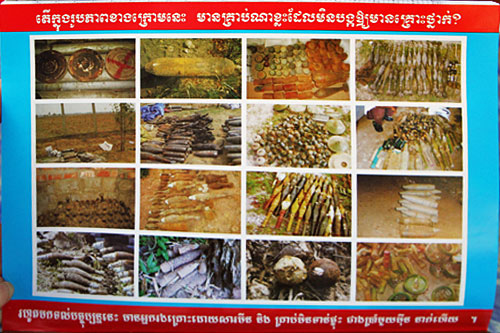
While the UXO Survivor Information Center assists those who have been victims of UXO, the Mine Advisory Group (MAG) in Phonsavan works tirelessly to rid Laos of UXO, training crack teams of Lao how to safely disarm bombies. In MAG’s back room I watched the documentary for a second time, astounded that I never knew about what Lao call “The Secret War,” especially since I am a child of the Vietnam War era. When it finished I rose slowly from my chair and filed out with the other attendees. No one said a word. We were all sickened by what we had learned. Considering the tonnage of explosives that was dropped on Laos, I wondered how anyone in the country survived. Then, I wondered why Lao are even willing to speak to me. When I posed this question to the young man who had screened the film for us he replied, “War is war. We had a lot of anger toward American during the war but now it is over.” I wish I could be quite as forgiving; I am appalled that my government is not doing more to remedy the mess they have left in Laos.

“Estou aqui no distante e fechado Laos, cidade de Phonsavan” (um brasileiro, uma câmara c/ self-timer, sozinho e Deus!…)
That is disgraceful that the U.S. hasn’t cleaned up the mess they made decades ago and children and still paying the price. The local who showed you the film said the war is over and they don’t hold a grudge against the Americans. This is not completely true, for an unknown number of Hmong in Laos the Vietnam war continues with the Communist Government engaging in brutal attacks against the Hmong who are hiding in fear in the mountains.
The Hmong were trained to fight for the Americans in the war, and when the Pathet Lao took over Laos in 1975, when the Vietnam war officially ended and the Amercans left, the brave Hmong who helped the Americans and sacrificed their lives were abandoned by their American allies. The Communist Government has engaged in a horrible campaign of genocide against the Hmong in hiding, many refuse to surrender and risk being imprisoned or worse. I doubt many of the tourists who see the beautiful scenary are aware of the atrocities that go on in the country away from the popular tourist areas.
Go to FACTFINDING.ORG to see evidence of the genocide in laos, and also http://www.usp.com.au/fpss/case-hmong-watch.html. Plus there’s heaps more info if you look on the web.
Thank you for this information Little Survivors. Good to know.
You are dramatically ill-informed on the War in Laos….for starters, the “missile” in your photo outside the restaurant is in fact a fuel tank. And, as a matter of FACT, the vast majority of the bombing was done by Laotian pilots and directed against North Vietnamese troops who invaded the country in violation of the Geneva Accords. Next time you visit I would suggest you speak to some of the Hmong Tribesmen and give them an opportunity to set you straight.
For the record, I was there.
Hello G62:
For the record, I spoke to a number of local Lao (though I can’t say any of them were Hmong), and to people from three organizations that are trying to either remove bombs, help those that have been injured, or teach children about the dangers of touching bombies that they find, one of which is partially funded by the U.S. State Department. So at the moment, it seems that the Lao government and the U.S. are not disagreeing about “the facts.” Though I’m certainly not one to accept at face value what our government says is truth, it makes no sense that they would agree with facts that make us look so bad. Certainly the bombings had the tacit approval of the Royal Family, who looked away as we bombed, since they also wished the NVA to be ousted, and perhaps there were Lao pilots who flew bombing runs as well, but many American pilots have documented that they flew these missions and the Lao certainly didn’t manufacture the cluster bombs themselves. You were there – please feel free to enlighten us further. I am interested and I’m sure my readers would be as well.
For starters I would suggest that you read “The Rough Guide to Laos” Cranmer/Martin, published in 2007. Pay particular attention to pages 326 through 340. although there are substantive errors/bias on page 330, the gist of this section is accurate.
Then read “The Ravens” by Christopher Robbin, follow it up by reading his book “Air America”, and the book “My Secret War” by Thomas Drury.
Peruse the website “Ravens.org” and broaden your horizons…..for the record, “We” did NOT indiscriminately jettison bombs all over Laos….when primary targets were unworkable, we utilized the weaponry on SPECIFIC sections of roads along the major infiltration routes from North Vietnam…. these sections were chosen due to the steepness of terrain bordering the road boundaries which made it more likely to close the road than bombing elsewhere….
I am now 64; during my year in SEA I was 23….while visiting the Phonsavan area during 2008, I had many, many discussions with my guide and my driver, who had been absolutely misinformed during their schooling while growing up in the PDR….they were taught pure propaganda; if the information you used in generating your tale of the Secret War came from informants younger than, let’s say 40 years old, they were not even alive in 1970… anyone younger than 50 would have been EXTREMELY young during the time period 1966 through 1975.
When I read about events like this and – let’s say – the bombing of Dresden, Nagasaki, Hiroshima, the Somme offensive, the partition in India, – the list goes on – it makes me wonder how anyone who has suffered under it remains even halfway sane.
The Laos bombing was reported in the British press long before it hit the mainstream press in the U.S. I never understood how it remained under wraps for so long.
Wow, I had no idea. Thanks for sharing Barbara.
Evocative post, Barbara!
Great story and beautifully personalised with real cases. While the legacy of this for Laos will be many more decades, we can only hope that the world rids themselves of this cruel and indiscriminate war technique that affects civilian populations. Sadly the latest convention against cluster bombs still remains unsigned by major countries including the Unites States, Russia, China, India, Pakistan, Canada and most of the Middle East – not a sign that the world is coming to its senses for these needless weapons.
Great post Barbara. There is a really good book all about the secret war that Johnson and Kissinger orchestrated – but I looked and now I can’t find it as I can’t quite remember the title. Timely that I read this now as I just visited one of my very good Vietnamese friends who lived in Da Lat and she is blind and missing an arm thanks to a bomb she accidentally played with when she was 7 years old. A truly amazing story and woman.
Thanks for sharing this as I know many people don’t even have a clue that Laos was a bystander of the Vietnam war.
Barbara, thank you for sharing this heartbreaking story. It is horrifying to know what we have done to the people of this country. What shocks me most is that most of us are not even aware of this “secret war” and the terrible history of what we’ve left behind in this incredible country. I so admire the Lao people who are able to forgive this atrocity and understand it wasn’t the done with the knowledge of the American people.
Wow. Thanks for sharing. That is truly horrifying.
Thank you Barbara– I have even heard that US pilots were asked to “unload” all of the bombs that they hadn’t dropped in Viet Nam into Lao on their way out. It is very sad. I, too, wonder how the Lao people can be so sweet and friendly to the American visitors. War is war, but I wish that all of the politicians that were involved in this could be brought up on charges. Lao’s only sin was being too close to Viet Nam.
Hi Vayabien: You are absolutely correct about pilots being told to dump their bombs if they were unable to complete their runs over Vietnam. In those days the air force was being allocated older bombs and it was not considered safe to land with them. So they used Laos as a dumping ground in addition to everything else. I’m sickened by the whole thing.
Interesting and thought-provoking piece, Barbara. It must have been difficult for you to write. Well done.
I don’t understand how the US could break a treaty it had signed and not be penalized. What is the point of having treaties if they can be so easily broken I wonder? War, indeed, is war, and I do believe that during history some have been unavoidable, but officially this wasn’t even a war! I do also wonder if this was another result of Lee Harvey Oswald’s contribution to history? Part of me would like to think that had JFK lived this wouldn’t have happened.
As a traveler you help people to understand that this atrocity wasn’t done with the consent of the American people, though we constantly hear that people of other countries blame governments and not citizens for these sorts of things.
I am firmly convinced that there are two things which bring people together. One is music, and the other, though I don’t have an inkling of why (not a fan!) is soccer!
Thanks Linda! It was indeed VERY difficult to write. I wrote a paragraph
here and another there for more than a month and finally today was able to
put it all together. I’ll be done with Laos soon, moving on to Koh Mak,
Thailand and then Scotland, which will be a bit more upbeat. Take care and
big hug to you
Oh—- I’ve been to Ko Mak— loved it!!!!!
Great post, Barbara. What a sad story.